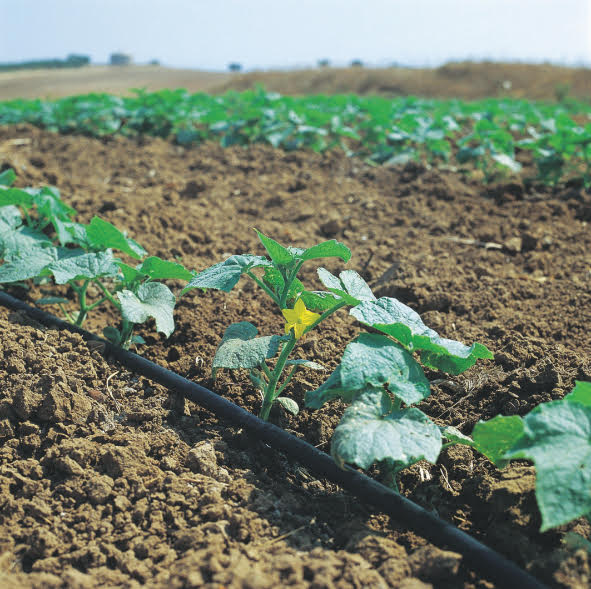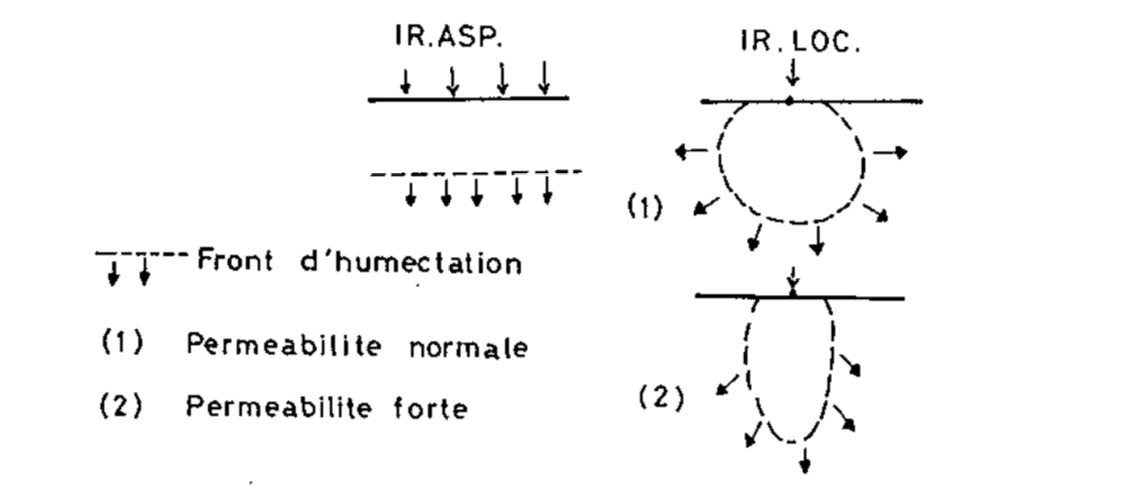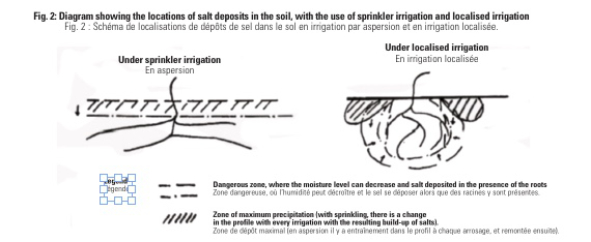Localised irrigation has developed rapidly since the 1970s, particularly on crops where sprinkler irrigation was used previously: orchards, market garden crops.

The main features of localised irrigation are that the water is directly applied close to the ground on a frequent basis. Only some of the soil surface is wettened, and, therefore, this only affects a part of the soil volume. On the other hand, as far as sprinkler irrigation is concerned, the water is sprayed from a certain height above the ground; therefore, the droplets fall onto the ground with some intensity and a certain force.
Consequently, apart from anything else (equipment, required labour, energy balance, carbon balance…), these two methods differ significantly in a strictly agronomic sense, given their effect on the microclimate-soil-plant relationship.
In this article, we intend to look at the different aspects from an agronomic point of view and, for each one, compare the two main irrigation systems. Finally, an overview of a few examples will enable us to show which aspects influence the choice of one or another of these systems, looking at things from an agronomic perspective.
I. The type of crop
Localised irrigation was basically used initially on perennial crops because moving the tubing each year would have required a lot of work and also cause significant wear and tear. Furthermore, most of these crops have a lower planting density than annual crops, which reduces the investment costs.
However, from the beginning, there have been a number of exceptions, such as:
• sugar cane, for which drip tape was used – and burned at the end of harvest (so what about the environment!),
• and the market garden, field or greenhouse crops, which are sufficiently intensive and of a high enough added-value to enable the price of such a system to be offset, despite its high renewal cost.
A certain number of experiments and projects have sought to introduce localised irrigation to high density annual crops (maize or corn, for example), but they have not produced enough evidence to show that it would be suitable for these crops.
II. The soil
Three main factors are considered when choosing an irrigation system:
• its behaviour on the surface,
• its structure deeper down in the soil,
• The way the wetted area or wetting front advances within the soil.
Firstly, let us look at the behaviour of the soil on the surface when under irrigation. A compacted crusting soil, i.e., a soil that has a tendency to lose its structure and form a crust on the surface, - through the clustering of the fine particles that are compressed by the droplets – is not very suitable for sprinkler irrigation, particularly if the droplets fall onto the soil surface with a high degree of energy, as in the case of a sprinkler gun.
This phenomenon of crusting or compaction can be particularly significant if irrigation is required before the planting of the crop, on a soil surface that is still bare. There is a risk of crusting on the surface and seedling emergence could be compromised. This could also lead to a lack of air in the rooting zone. This phenomenon could also occur on a perennial crop which would be grown without grass cover. In this case, localised irrigation would be preferred.
Furthermore, localised irrigation could make it easier to employ surface tillage, since the soil remains dry in part, or even remove the need (for tillage) altogether, since the purpose of this activity was weed control (fewer in number) or improving the structure of the soil surface.
Another aspect of localised irrigation could be of interest: unlike sprinkler irrigation, localised irrigation helps to avoid the stagnation of surface water or the occurrence of very significant runoff, with the risk of erosion, in the case of rain falling just after or during an irrigation. In fact, the dry part of the soil surface could still absorb the water applied from rainfall.
Finally, in certain cases, with localised irrigation weeds can be left to grow between the rows: they are less numerous than with sprinkler irrigation and they compete less directly with the crop. They also allow, in certain cases, for a reduction in runoff and erosion.
The soil structure at depth. As a consequence of the points raised in the previous paragraph, a localised irrigation can allow for less frequent movements of tillage implements. The risk of soil compaction caused by these movements is thus reduced.
However, still on the subject of the internal structure of the soil, it is also important to be aware of the risk of clay and silt particles being dispersed by localised irrigation, which explains why it is so important for the drippers’ flow rates to be compatible with the hydraulic conductivity of the soil and the unit volumes compatible with its capacity (with intermittent and non-continuous applications).
Advance of the wetted front and progression of water in the soil.

We must now remind ourselves that the penetration of water in the soil, with sprinkler irrigation, is effected mainly through a lateral wetting front that moves in a downward direction. On the other hand, with localised irrigation, the soil tension gradient (we also speak about the opposing soil water potential which mainly includes the matric and gravitational potential) causes the movement of the water in all directions: low tension at the drip point, higher tension in the surrounding area due to absorption by the roots. A spherical front is formed around each point of application. This zone within the advancing wet area is normally known under the name of the “bulb”. In reality, depending on the diverse nature of the soil, textural or structural, this zone very rarely takes the shape of a perfect bulb, so we have been able to come up with a more specific term, the dripper’s zone of influence (ZIG). Thus, if the permeability of the soil is high, there is a risk, in the case of drip-type localised irrigation, or with a Bas-Rhône (BRL) system, of water being lost through deep percolation, with a vertically elongated bulb caused by the low lateral hydraulic conductivity. Therefore, we would prefer to use sprinkler irrigation, with quite frequent applications, in small amounts, or even localised irrigation using mini-diffusers, which can distribute the water to larger surfaces than the drippers.
However, when the permeability of the soil is low, possibly in a sloping field, localised irrigation, with frequent applications but in small amounts, will help to avoid losses through runoff.
III. Rooting system
The interactions between the rooting systems and the different types of irrigation are to be considered under differing circumstances, particularly when there is a risk of plant water stress, use of fertilisers, adaptation of one system to another, possible problems caused by a breakdown.

1. With localised irrigation being characterised by frequent applications, the variation in soil water tension or the availability of the water, is relatively slight over time. There is no long period of time when the water would not be available or only partly available.
On the other hand, with sprinkler irrigation, even when striving to apply quite frequent irrigation amounts, it is difficult to achieve the desired result.
2. Very often, localised irrigation allows for the fertilizers to be applied more efficiently, because they are applied to the place where the soil moisture conditions are the most favourable for absorption by the roots, and into the zones with the greatest root density. Of course, this is on the condition that the ranges of concentration and salinity allow the roots to function correctly.
3. With regard to the adaptation of the rooting system when changing from one system to another, particularly for the orchards, the situations may vary according to the species and types of soil. The adaptation of the rooting systems when changing from sprinklers to localised irrigation can happen quite quickly for some orchards with a relocation of the roots in the drippers’ zones of influence. Nevertheless, this is not always the case and it is best to remain cautious, and look for similar examples before contemplating a change.
Regarding the reverse scenario, when changing from localised irrigation to sprinklers, there could also be difficulties with the adaptation, with a risk of water losses in the zones unexplored by the roots, and this would happen during the whole of the adaptation period.
4. In the event of a breakdown in the irrigation system, the risk could be significant for localised irrigation, where the roots are less spread out and would be less likely to receive any possible rainfall in a satisfactory manner. And, above all, it would produce a rapid depletion of the water in the zone where the roots are most concentrated.
IV. The above-ground section
Even then, several different aspects need to be considered when choosing one or another type of irrigation system.
We will try and compile a review in this respect.
• Frost protection: only sprinkler irrigation is suitable for frost protection,
• Plant health perspective:
- The sprinkler irrigation installations can be used for certain treatments on the above-ground section, which would not be possible with localised irrigation. However, a treatment already applied will also run the risk of being washed away if an amount of water needs to be applied soon after the product has been applied to the leaves, an inconvenience that would not occur with localised irrigation.
- If there is a risk of fungal diseases, this could be aggravated by sprinkling, the inoculum being dispersed by the splash of the droplets of water; furthermore, the growth of the spores could be facilitated by the high level of humidity in the air during and immediately after sprinkling. This problem can be overcome by irrigating a few hours before sunset, if possible, at a time when evaporation is at its highest and when the leaves dry out quickly.
- In the case of diseases and parasites developing in the crown of the plants (fusarium, nematodes, etc.), sprinkler irrigation, particularly the above-canopy type, leads to the droplets becoming trapped in the leaves and finding their natural runoff along the stem, which is to be avoided. With localised irrigation, the dripper is moved further from the foot of the plant.
- In contrast, if a dry climate favours certain insect pests (tomato mites, for example), then it could be preferable to use a localised form of sprinkling, because this would maintain a certain humidity in the surrounding atmosphere.
- In the case of silted water, with fine sand or different particles in suspension (see salinity under §V), there is a risk of sprinkler irrigation damaging or tarnishing the leaves and fruit. However, with localised irrigation, this type of water can only be used with large-sized emitters, if the cost of fine filtration equipment is to be avoided (which, in any case, would resolve the sprinkler irrigation problem).
- In the same way, if the grower wishes to irrigate during the flowering stage, when the flowers are very delicate, localised irrigation may be preferred.
- However, for certain plants that are sensitive to drought or high air temperatures, sprinkler irrigation is preferred, with the amounts applied frequently, unless a misting type of localised irrigation is used (greenhouses), If, despite everything, the grower decided to go for localised irrigation, then plastic mulch should not be used.
- In the event of there being frequent wind drift then the uniformity of the irrigation will be better with localised irrigation than with sprinkling.
- One aspect often mentioned is saving on water, which can favour localised irrigation rather than sprinkling. This factor could be extremely important when water is scarce. As far as the above-ground section is concerned, during and just after an irrigation, in arid and windy conditions, high evaporation could be experienced at three levels: during the trajectory of the droplets in the open air, from the soil surface and from the droplets falling onto the vegetation. In a temperate climate, there is only a slight risk, unless irrigation is carried out during the hot hours of the day. Furthermore, localised irrigation allows for the applications to be more finely adjusted than with sprinkler irrigation, considering, for example, the age of the vegetation and the different growing stages.
- Finally, sprinkler irrigation can cause some problems when watering the edges of the plots: unless there are some particular technical adaptations, they could be irrigated less correctly than the rest of the field, or the grower could end up wetting the paths or neighbouring crops (with the risk of mildew in the case of vines, etc. and water losses).
V. The problem of salinity
This problem arises when concentrations of dissolved salt deposited on the leaves and in the soil exceed certain thresholds, as per the ionic balance of these solutions. Some plant species are very sensitive to salt (stone fruits, strawberries, green beans, etc.), others are fairly resistant (potatoes, vineyards, etc.), and others are even more resistant (tomatoes, beetroot, asparagus).

Two aspects need to be mentioned:
• The use of water that is too saline. With sprinkling, there is a risk of leaf scorching. Regarding what is happening in the soil, the problems are the same as those encountered when there is a saline soil.
• In the soil: with localised irrigation, the tolerance level is lower. In fact, the salt remains in solution, even at a strong concentration, in the bulb (the dripper’s zone of influence), because the moisture content remains high over time.
We can map out the location of any possible deposits (see diagram above).
VI. Examples of use
Let us now look at a few practical examples of using the analysis of the above-mentioned agronomic criteria when making a choice.
Example 1: this relates to an orchard with crusting soil, in a temperate climate. It is often windy. It is also possible to protect against the frost.
There are several criteria here that point in favour of a localised system: this relates to an orchard (cropping density lower than that of an annual crop), the soil crusts; there are windy periods.
However, localised irrigation does not allow for frost protection, which would appear to be essential here.
In this case, overhead sprinkler irrigation would be used. The grower needs to check that there is no problem regarding the available flow rate and that the significant cost of installing the (fixed) system is justified. The problem of soil compaction or crusting could be mainly resolved by undersowing the orchard. Irrigation must be avoided during windy conditions. The grower must also organise his or her schedule in such a way that irrigation is applied before and not after treatment.
Example 2: a plot laid down to market garden crops, with very permeable sandy soil, in a temperate climate. Significant risk of fungal or crown diseases.
In this case, it is the plant health problems that predominate and present the greatest risks for the harvest. Although this is an annual crop (and perhaps even several crops grown the same year), localised irrigation will be chosen. It will be conceded that there will be greater wear and tear of the laterals and moving the device at the end of each season will require more labour. However, market gardening involves intensive cropping and the high irrigation costs can be easily offset. Moreover, the soil is very permeable and attention has to be paid to the amount applied in order to avoid losses through percolation. Similarly, there will also be a need to plan for quite a large number of drippers in order to overcome the low hydraulic conductivity of the horizontal soil-water movement.
Conclusion
We notice that, in the examples given here, for the irrigation method chosen, according to criteria considered as being crucial, only the advantages are given, which means that we are unable to resolve any problems. These could possibly be remedied by using other irrigation methods or by adapting the irrigation device, or even by combining a few different systems. Thus, at the present time, we can observe a shift from drip irrigation to a combination of sprinklers plus drip irrigation. However, micro-sprinkling may provide a compromise solution between very localised drip irrigation and sprinklers.
We can also present a case where agronomic criteria alone does not allow us to make a choice or enable us to have a strong preference for one system over another. Other criteria must then come into play: cost, equipment, labour, etc.
We can also see that, even in the examples put forward, these aspects are generally considered directly or even indirectly, insofar as the cost of a method chosen on an agronomic basis must be justified economically. These aspects that are not directly agronomic must be considered more fully so as to be able to choose from a wider range of technical devices available for the most suitable irrigation method. This will be the subject of our next article, discussing other aspects that complement the agronomic perspective, such as: European Union incentives, for example, hydraulic aspects, regulatory aspects, etc.

